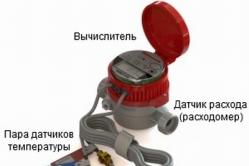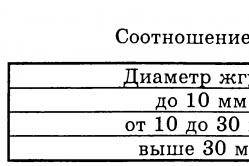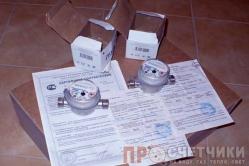Antipyretics for children are prescribed by a pediatrician. But there are situations of emergency care for fever, when the child needs to give the medicine immediately. Then the parents take responsibility and apply antipyretic drugs. What is allowed to give to infants? How can you bring down the temperature in older children? Which medications are the safest?
How do you feel about tees and twins working in household wiring? I guess that is ambiguous. They allow you to operate more electrical appliances than the number of outlets allows. But you should use them carefully.
This is what will be discussed below. I hope that my electrician's advice will help you, as a house-master, when repairing an apartment with your own hands, properly connect sockets to home wiring, use them safely and safely.
The idea to tell about this originated after the appearance of a comment from the reader Mmoguider to the article telling There I answered him briefly, and now I'm trying to explain in more detail.
What power is the socket used for?
When paying attention to the rated current at which it can be used for a long time. Its value is marked on the back of the case.
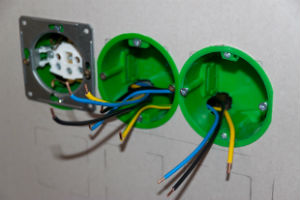
This denomination can not be exceeded. Otherwise there will be a mode when the temperature heating from the passing current will significantly exceed the ability of the design to transfer heat to the environment. This will lead to burnout of contacts, may cause a fire.
Imagine that a socket for 6 amps includes a tee with a connected TV, a stationary telephone power supply and charger cell phone, as shown in the very first photo, or a more powerful 1000 watt iron.

Through the outlet and the plug or tee inserted into it, the load current will flow to all connected consumers.
Directly on the picture is a calculation of the workload, which will be 4.5 A, which is less than the nominal value. Hence, we have a power reserve, and the socket is not overloaded.
However, if you supply a washing vacuum cleaner with 2000 watts of power, then the current will be 2000/220 = 9 amperes. This value is greater than the socket can withstand and its mechanism will burn.
What is the power for domestic household wiring
We came to the conclusion that the current in the socket can be:
- normal for switched devices;
- or critical, creating the prerequisites for the occurrence of accidents in household wiring.
Let's focus on the second point. Electricians are well aware that all sockets are connected in parallel. This means that the total resistance of their consumers increases the total current through home wiring.
Normal operation mode
Consider two groups of consumers, fed by their own chains:
- refrigerator with a power of up to 1000 watts through a socket for 6 amperes and its own circuit breaker;
- a washing machine and a vacuum cleaner of 2000 watts each, powered by individual 16 A plugs through a separate power circuit breaker.

All the chains and sockets work in normal mode, they have a reserve for current and power reserve. The current in the two outlets does not exceed 9 amps. At the same time, through the automatic switch will go 18 A, which is unacceptable for a nominal value of 16. Therefore, the machine must be chosen larger: 20 or 25 amperes.
An introductory circuit breaker will pass through itself 22.5 A, which will eliminate its nominal value by 20 ampere.
Emergency operation mode
The number of consumers is the same, but their connection is made via a tee to a single 16 amp outlet.
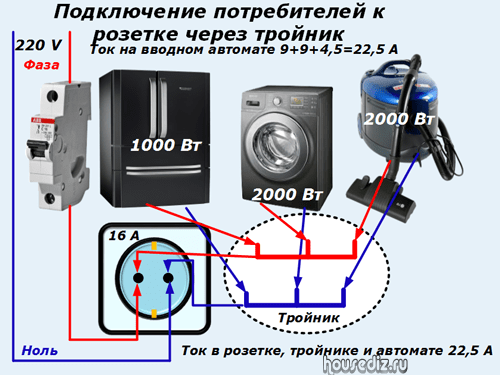
All currents from consumers are collected in a tee. Do you know exactly its ultimate load?
My work is the same as in the first photo. Its rated current is only 6 amps.

However, we will continue the analysis, assuming that the tee will not burn, although this is unlikely. All currents of 22.5 amperes will flow through a 16 A socket and an automaton. There is an emergency situation, which must be prevented by protection.
How to choose the wiring
Let's pay attention to this issue because the current-carrying veins must reliably transmit the electric power applied to them, creating heating of the metal and its insulation no higher than the permissible temperature. Otherwise, the dielectric layer will be violated and leakage currents will flow through it.
Then the phase potential can be at any time on the body of household appliances or metal building elements, which will lead to electric trauma of the tenants. The only way to prevent them is. And if it is not, as usually happens, then troubles are secured.
We remind you that in places of poor connection of wires and broken electrical contacts, the temperature increases abruptly. It can lead to a fire.
Wires in old buildings
The principle of providing the population with electricity in the Soviet times was solved by creating several standard projects of laying wiring in apartments. Then it was the best option for solving the problems of state construction.
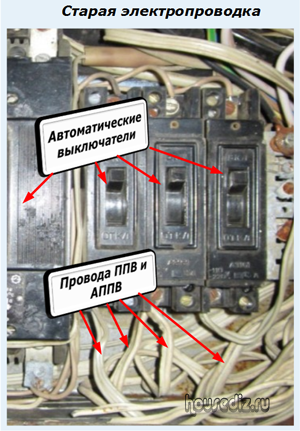
The wires, taking into account the low load by current standards, were made of aluminum wire of 2.5 sq. Mm. At the entrance to the apartment worked a counter for 5 amperes, and in each room there were two sockets. Their power reserve was sufficient.
Now the power of household appliances, and their number in each family, increased dramatically. And people live with it and use tees and extension cords, which can lead to sad consequences.
Current loads can create emergencies in the old aluminum wiring, which is designed for a maximum of 20 amperes.
Modern wiring
Aluminum wires and cables for laying in living quarters are already prohibited by the current rules. In the old buildings, some of their tenants change their own hands, while others continue to exploit, hoping for a Russian "maybe".
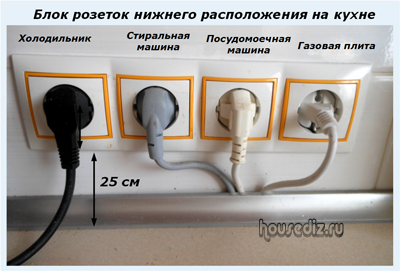
To connect the sockets use only copper wires and cables with a cross-section of cores for 6, 4 or 2.5 sq mm. It should be taken into account that they can withstand the average current for 27 A for 2.5 square meters, 38 for 4 and 46 amperes for 6 mm square. It does not make sense to consider large loads.
How automatic protection provides electrical safety
We disassembled the normal power supply modes of household appliances in terms of the loads they create for wiring and sockets. These currents must be reliably transmitted from the source of electricity to the consumer.
Now let's assume that inside the washing machine the water hose has bursted, and the potentials of the phase and zero have closed on the wet place. Or, for example, an inexperienced home master drilled a live cable.
In both cases, a short-circuit current will immediately occur, which is accompanied by an electric arc. Its power not only burns insulation, but melts the wiring, splashing liquid copper metal with sparks in all directions.
To prevent the development of a fire, use automatic circuit breakers, which in a fraction of seconds completely relieve tension from the equipment they protect. They should be properly selected in many ways.
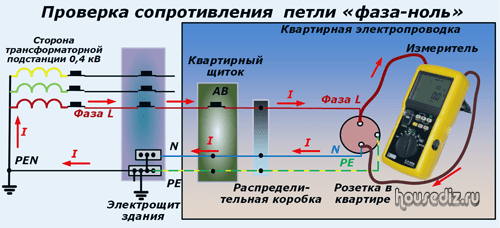
This issue is set out in a separate article and the principles of its work. We recommend that you read it. Pay special attention to checking the "phase-zero" loop. So far, very few people do. And this is very important.
How to connect the outlets affect the load on your home network
Wiring technology electrical wires inside the apartment can be performed by various methods. This topic is detailed in the article under tension. Check out.
One of the methods of providing a room design with an old wiring is to use the socket blocks, as shown in the photo.
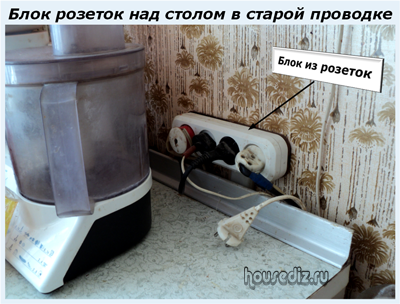
Just do not forget that you need to constantly monitor the load connected to it and not allow it to exceed for the ratings of the outlet mechanism, the used wires and circuit breakers.
The safest way to connect the sockets is radial with their feeding from individual machines. Since it is the most expensive, and the method of the loop is risky, it is optimal to switch the outlets in a mixed version with monitoring of the current loads.
It's time to sum up: it is necessary to connect the outlet to the household network reliably and safely. A home master, in carrying out this work, must maintain a balance between:
Pay attention to all 4 points. And now we recommend watching the video of the owner RozetkaOnline "How to connect the outlet".
- Печать!}
Consider the calculation of the load. For calculation, you have to use only one formula: Current (A) = Power (W) / Voltage, 220 (V).
For consumers, the devices that you will "stick" into the sockets, the main characteristic that we need is power (watts, kilowatts). It is usually indicated in the passport and / or on the device itself.
For outlets, plugs, security devices, another characteristic is the current strength (amperes). Look for the markings on the body of the product.
Now let's try to make simple calculations. "Dancing" is necessary from those devices that you plan to use in your bath, for example:
♦ 1 lamp in the steam room - 60 W;
♦ 1 lamp in the shower - 60 W;
♦ 1 lamp in the dressing room - 100 W;
♦ 1 lamp for porch lighting - 100 W;
♦ refrigerator - 200 W;
♦ fan heater (or other heating device) - 2000 W;
♦ pump - 600 watts.
TOTAL: 60 + 60 + 100 + 100 + 200 + 2000 = 2520 Tues.
Note.
The power of individual devices may be somewhat different, but for calculations this is unprincipled.
We substitute the obtained sum in the formula: Current (A) = 2520 W / 220 V. It turned out: 11.45 A. Not much. We select a wire. Here are some approximate figures for the ratio of wire cross section to current: 1.5 mm 2 - 16 A; 2.5 mm 2 - 25 A; 4 mm 2 - 32 A; 6 mm 2 - 40 A. All this applies to a wire with a copper current-carrying core.
Attention.
Aluminum is not allowed in houses for internal wiring. And even if you have the reserves, use an aluminum wire for a number of good reasons is not worth it.
Thus, in order to pass a current of about 12 A it will be enough copper wire section 1.5 mm 2 or, as they say, one and a half squares. But we put the wire for a long time.
It is not known how the circumstances will develop in the future. Maybe we will want to install in the sauna some other electrical appliances. For example, boil a samovar or kettle, heat the water with a water heater or external power outlet connect the circular. Of course, there is little likelihood that all this will work simultaneously, but the accident is also an accident - what the hell is not joking?
Council.
♦ up to 4 mm 2 - from the shield in the house to junction box in the bath;
♦ up to 2.5 mm 2 - trunking, going through the room and to the sockets.
It is desirable to purchase sockets designed for a current of at least 10 A, better - 16 A. Then you can be relatively calm. In the switchboard at 16 A socket we put an automatic switch (VA) with a nominal value of no more than 16 A.
If you bought ten ampere sockets, you will have to put the VA at 10 A. And no more.
Note.
The circuit breaker is selected by the weakest link in the electrical circuit.
VA will protect from short-circuit and overload in the network. Suddenly, someone will plug in a single socket immediately heater (2 kW) and the same power electric kettle. The current that flows through the circuit will be 18 A, which will exceed the nominal value of A3 (16 A), and it, after a while, will trigger the trip. The socket will not start to heat up like an iron - a fire will not happen.
If a more extensive network is planned in the bath, then an additional switchboard, where to mount several automata and RCD, protecting different circuits. For example:
♦ main switchboard - automatic switch (VA) UI + N 25 A, branch wire to the bath - 4 mm 2;
♦ switchboard in the bath (РС) - У3040А 30 mA, VA 16 A: wire 2.5 mm 2 - sockets 16 A - 2 convectors for 1 or 1.5 kW; VA 16 A - wire 2.5 mm 2 - sockets 16 A - water heater 1,2 kW, pump 0,6 kW, refrigerator 0,2 kW, other minor load; BA10 A - wire 1.5 mm 2 - lighting fixtures.
For those who are very concerned about their electrical safety, it is necessary to protect the lines in the therma and washing compartment of the RCD 10 A or 16 A 10 mA or to connect the load through the isolating transformer.
So, how to install a socket is a serious occupation, we found it necessary to publish this article, with which you will learn all aspects of this case, not only how to properly install the outlet, but also how to calculate its power and how to connect it to the power grid.
After all, from the properly assembled outlet, the fire safety, the proper functioning of the network as a whole and the consumers (appliances) connected to the socket depend. In addition, the work for only 5, well, 10 minutes with the installation for everything, everything, and for the average tariffs of electricians the work is estimated at 2-3 $. In general, a small but informative article.
Ways to install the sockets
 Installation open way
. On the plane of the wall are installed podrozetniki of heat-resistant, conductive material thickness of 10mm (textolite, getinaks, asbestos cement, etc.), on which and install a socket of this design, designed for open fastening. The housing of the outlet is removed, the wires are connected, the socket is screwed to the sub-socket and the housing is put on.
Installation open way
. On the plane of the wall are installed podrozetniki of heat-resistant, conductive material thickness of 10mm (textolite, getinaks, asbestos cement, etc.), on which and install a socket of this design, designed for open fastening. The housing of the outlet is removed, the wires are connected, the socket is screwed to the sub-socket and the housing is put on.
Closed installation . A drill with a crown is drilled in a hole in the wall, the mounting box is laid on the alabaster or on the dowels, preliminary withdrawing the wires into it. With the outlet removed plastic housing, connect the wires, and, after hardening the alabaster is laid in a junction box and fixed, fastening the fasteners to the box.
Ways to connect the wires to an outlet
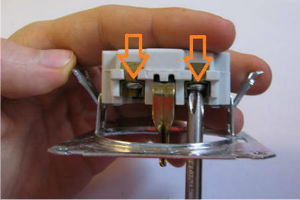 Screw connection.
The stripped wire is inserted into a special hole and clamped with a screw. This connection is considered less reliable, since a current that has a frequency of 50Hz (household current) creates oscillations, the vibrations due to which the screw loosens with time and begins to shorten, which is a fire hazard factor; From time to time, it is necessary to tighten the screw connections, without waiting for the socket to melt.
Screw connection.
The stripped wire is inserted into a special hole and clamped with a screw. This connection is considered less reliable, since a current that has a frequency of 50Hz (household current) creates oscillations, the vibrations due to which the screw loosens with time and begins to shorten, which is a fire hazard factor; From time to time, it is necessary to tighten the screw connections, without waiting for the socket to melt.
Clamping connection. The wire is inserted into a detachable hole, expanding when a special button is pressed. When the button is released, the hole is compressed, tightly wrapping the stripped wire in the clamp hole. When it comes to the height at which the sockets are installed, it is at least 25 cm from the level of the finishing floor and 50 cm from the heating appliances.
 Sockets are designed for a certain maximum permissible current, therefore the installation of sockets with a lower permissible current strength, relative to the electrical network is unacceptable. Eurosockets can be designed for 10A and 16A. Voltage of household electrical network is equal to 220V.
Sockets are designed for a certain maximum permissible current, therefore the installation of sockets with a lower permissible current strength, relative to the electrical network is unacceptable. Eurosockets can be designed for 10A and 16A. Voltage of household electrical network is equal to 220V.
Based on these data, it is possible to calculate the allowable power consumer device, connected to this outlet: 16A x 220V = 3520W; 10A x 220V = 2200W. But also the sockets of the old sample 6A are produced: 6A x 220V = 1320W; in them, by the way there is no grounding, therefore, they are not quoted according to the euro standard.
For the average life of an average family, more electricity is required. This is due to the fact that the welfare of the population of our country is growing, new types of various household devices are appearing.
Increasingly, it turns out that the number of outlets in the apartment is limited, and there are a lot of devices that need to be connected and constantly used.
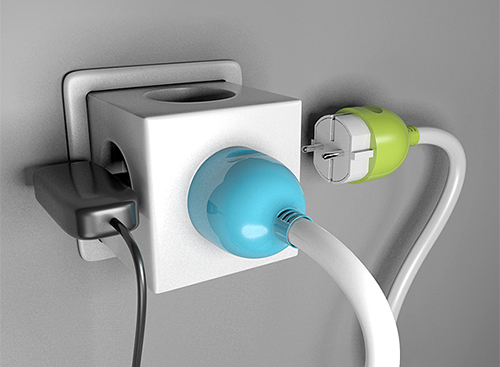
In a single outlet you can connect only a limited number of electrical appliances
What load can stand one outlet?
The question of how many forks can be plugged into an extension cord, rather confusing. After all, there are many factors on which endurance depends electrical wiring in each case. In order to determine the possibilities of one outlet, it is necessary to understand some concepts and definitions.
Voltage. This is a physical quantity that shows the work of moving the charge from one point electrical circuit to another. The unit of measurement is the Volt. Voltage 220 V is accepted for our country. This figure must be taken into account, as it is used to calculate the load that the socket can withstand.
Current strength. This is the ratio of the amount of charge that has passed through a certain surface to the time of this passage. It is measured in Amperes. For our outlets this value is basically from 6.3A to 10A.

Instruments for measuring current intensity
Power. Shows the speed of conversion, consumption or transmission of electricity of any system. It is measured in Watts. The power of electrical appliances is indicated in technical characteristics, as well as, as a rule, on the case.
Permissible load on the socket is an indicator of the amount of watts that can be sustained by both the socket itself and the wiring, with the simultaneous operation of several devices or one powerful device.
A simple calculation with the indicators available to us will look like this: to calculate the permissible amount of watts, you just need to multiply the current by the voltage. For our domestic outlets this calculation will look like this: 6.3A * 220V = 1386W. Thus, the total power of devices that can be simultaneously connected to a single outlet should not exceed 1386 watts.
Protection against power surges in the apartment
In order to prevent power surges in the mains and to protect the wiring from overload, care should be taken when using extension cords and tees. When an overload occurs in the network, the wiring starts to heat up and a short circuit or fire may occur.
Another important factor is the cross-section of the wiring (simplified - its thickness), on which its endurance depends. Therefore, ideally, it is necessary to calculate the load not only on individual outlets, but also on the entire electrical network of the apartment. Then it will be easier to determine the total permissible power of electrical appliances, lamps and chandelier . Such precautions are especially useful in old homes.
In order to avoid problems with the lack of outlets, it is necessary to plan their location and quantity in advance. When the apartment is overhauled, the wiring is often completely replaced with a new one, with a large section. In this case, it is permissible to install euro-sockets, the current strength in which is from 10A to 16A, the total power of electrical appliances, respectively, can be much larger.
There are some rules for which there should be at least 2 outlets in each room (1 for every 4 sq. M of area), and in the kitchen - 4. But, for today, this number is not enough. In order not to overload the existing sockets, it is better to conduct additional ones, taking into account the total permissible load on the wiring.
Observing simple precautions, as well as maintaining the wiring in the house in good condition, you can protect your home from a fire and keep the appliances for a long time in working order.
Few people come to the study of the question "how much amp in the outlet" from idle curiosity. Usually this kind of problems arise during repair or if something has ceased to function. Nothing remains, how to remember how many amperes in a 220V socket.
What are machines?
The easiest way, as it is possible to find out the necessary information, is to look at the machine on the sockets. How many amperes, it is indicated by large numbers right on the front side.
In civil engineering, nominal values of 6 A, 10 A, 16 A, 25 A, 40 A and 63 A are most often used, although there are others.
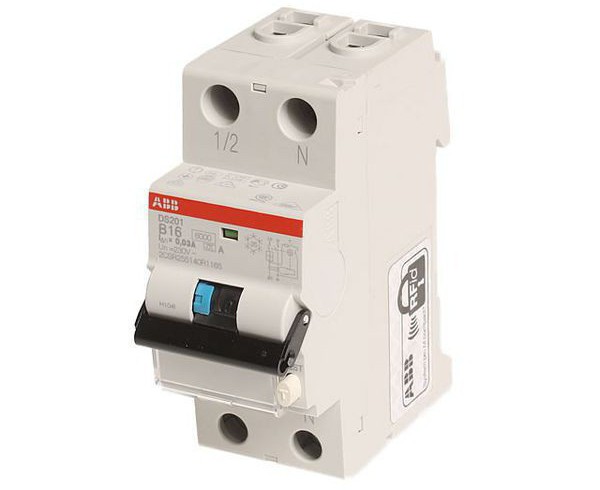
Calculations
If a person knows the allocated power for a certain electrical line, then how many amps in a 220-volt socket can be learned by applying a simple formula. In theory, everyone had to meet with her in the school course of physics.
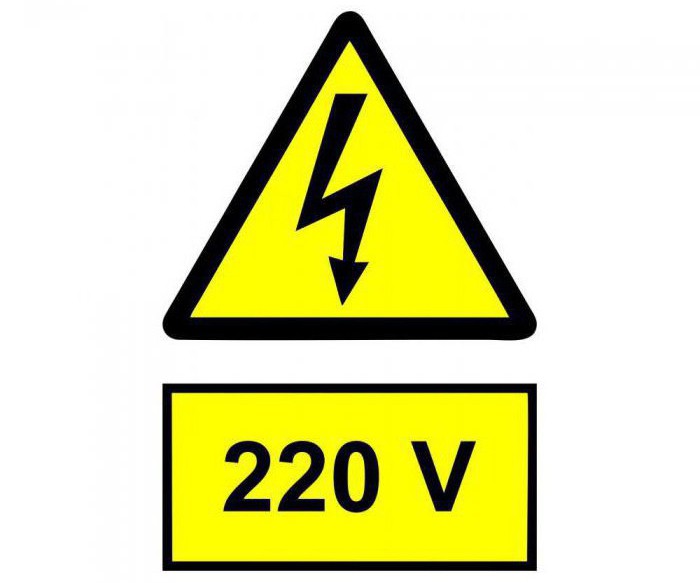
As is known, power is the result of multiplying the voltage by the current. In the classical version, it looks approximately like P = U * A. How much amp in the socket is calculated by dividing. A formula of the form A = P / U should be obtained.
For clarity of calculations, how many amperes in a 220V socket in Russia, we substitute numbers. Let us assume that the allocated power of the line is 1.32 kW. Accordingly, in order to find out how many amperes in a 1320 W socket we will divide by 220 volts. We get 6 A.
How to choose an outlet
Before you go to buy, you need to find out how much the amp socket can withstand. Knowing this is not just important, but necessary. If it is not taken into account, how many amperes in the socket can be used as much as possible, extremely unpleasant consequences are possible - cable fusion, damage to metal parts, and then - a short circuit.

The most important thing that the consumer should be interested in is the power of the device.
By the modern standard For home networks, an ordinary socket should correspond to a value of sixteen amperes.
Is this a lot or a little? Let us return to the formula. Sixteen amperes are multiplied by two hundred and twenty volts and we get three and a half kilowatts.
For the sake of interest, let's go through the power of the main household appliances. Depending on the model and characteristics, the indicators may vary, but in general for powerful consumers they look like this:
- Air conditioning - up to one and a half kW.
- Washing machine - one kW.
- Iron - two kW.
- Fan heater - two kW.
- Oil heater - two kW.
- The boiler is two kW.
- Microwave - one kW.
- Multivarka - one kW.
- Vacuum cleaner - up to kW.
- Electric boiler for heating - from 3 kW.
- Electric stove - from 3 kW.
Judging by the sample, for the overwhelming majority of powerful, not to mention the lamps, floor lamps, fans and similar insignificant appliances, the outlets at sixteen amperes are out of stock.
However, there are always exceptions. An electric stove, especially induction, can consume five and nine kW. And although you understand that the socket can withstand only 16 amperes (3.5 kW), but you really want to include it. What to do in such cases and how to avoid it?
Protection
It has already been mentioned above that a mismatch of the rated current that a socket can withstand, will lead to a short circuit.
For even the theoretical exclusion of such an action, which can lead to very serious consequences, three systems of protection are used at once.

If everything is clear with the first point, then the second and third question should be considered in more detail.
General information about the cable
The attentive reader must have noticed that all the cables are different. The most important difference is the metal that makes up the vein. Long ago, at the dawn of electrification, steel was used. But from the fragile, unreliable metal with the big losses in due course have refused.
Aluminum was used in Soviet construction. Not the very one who can also break down while repairing, but, nevertheless, he performed his function reasonably enough and was pleased with the low price. However, his time has passed.
Inside a modern residential building, according to the standard, it can be exclusively copper wiring. And it's far from the prejudices of builders and inspectors. In the event of a short circuit, the yellow metal melts at a temperature above 1,000 degrees, and aluminum melts slightly over 600. When is a fire more likely?
It is worth noting that such strict requirements only apply to civil construction. In all other cases, aluminum is used quite often.
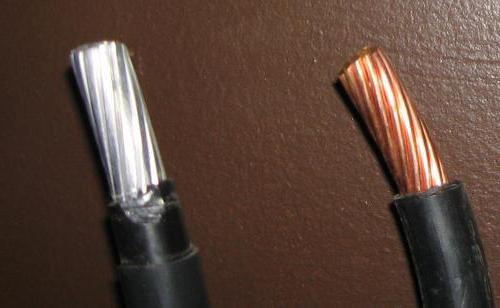
Cable cross section
Again, it is worth remembering the course of physics and to understand that the thicker the cable, the greater the current for a home socket it can withstand.
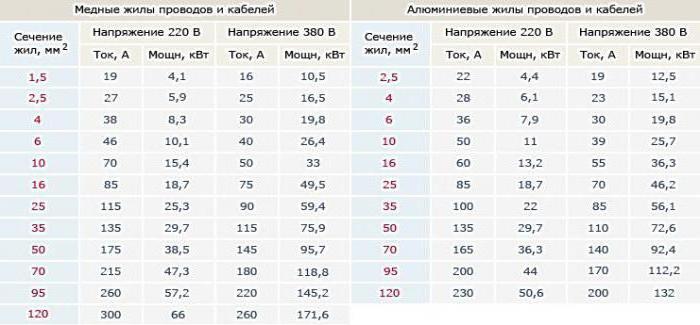
In the home socket, the insertion holes are made ideally under a cross section of 2.5 square millimeters. Why is that?
We look at the copper table. At 2.5 square millimeters, a maximum of almost six kilowatts and a current of twenty seven amperes can occur. For a value of one and a half, these figures are one and a half times less. Each connection must have a certain power margin for safety reasons. But too much cross section will contribute to absolutely unnecessary energy losses. We need an ideal balance, which was found.
So even if someone is lucky to include a very powerful device into a power outlet with maximum power sixteen amperes, nothing will happen to the cable, because it is laid with a margin. However, for the plastic and hardware itself, this connection can be fatal.
For this, the third protection is provided.
Circuit breaker
All of us, even secretly from ourselves, are trying to deceive someone. If there are not enough outlets in the room, and there are many devices, sooner or later it will be necessary to turn them on at one time. Most often this happens in the winter. Carriers and adapters are not the best friends. The increased load, as we remember, will end badly both for the outlet and for the cable to which it is connected.
To protect against this deception, an automatic machine is created, it is also a package. Inside this simple mechanism is a membrane or spring, or other device that heats up.
If the current passing through the machine exceeds the nominal value of the machine, it turns off, thereby protecting the home from a fire. The operating value can be restored exclusively by hand by clicking the toggle switch.
A standard machine for a cable is 2.5 square millimeters, from which, ideally, the sockets in the living room are powered - sixteen amperes, or 16 A * 220 V = 3.5 kW.
For one and a half squares, which are usually used for lighting, 10 A or 2.2 kW.
In principle, there is nothing to prevent the machine from putting a 2.5 square millimeter on the cable, say, six amps. It will be switched off when the load exceeds 1.3 kW. But the standard is still used 16 A - in this case the use of electric power the most balanced and safe.
Conclusion
Electricity is extremely interesting and tightens with the head. The main thing is to understand it. If, after reading the article, the principle of choosing a power outlet is not clear, it is better to consult a professional for advice and installation. The electrician, like the sapper, is mistaken once.

